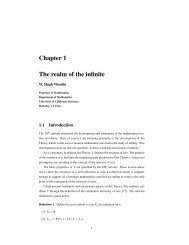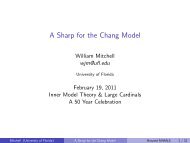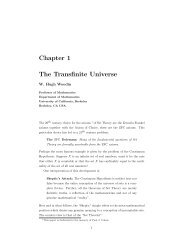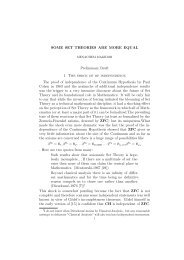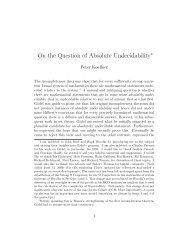The Continuum Hypothesis - Logic at Harvard
The Continuum Hypothesis - Logic at Harvard
The Continuum Hypothesis - Logic at Harvard
Create successful ePaper yourself
Turn your PDF publications into a flip-book with our unique Google optimized e-Paper software.
the fact th<strong>at</strong> under (∗) the theory of H(ω 2 ) is in fact mutually interpretablewith th<strong>at</strong> of H(ω 1 ) (by a deep result of Woodin). Moreover, this l<strong>at</strong>ter factis in conflict with the spirit of the Transcendence Principles discussed inSection 4.3. Those principles were invoked in an argument to the effect th<strong>at</strong>CH does not have an answer. Thus, when all the dust settles the real importof Woodin’s work on CH (so the argument goes) is not th<strong>at</strong> CH is false butr<strong>at</strong>her th<strong>at</strong> CH very likely has an answer.It seems fair to say th<strong>at</strong> <strong>at</strong> this stage the st<strong>at</strong>us of the local approachesto resolving CH is somewh<strong>at</strong> unsettled. For this reason, in the remainder ofthis entry we shall focus on global approaches to settling CH. We shall verybriefly discuss two such approaches—the approach via inner model theoryand the approach via quasi-large cardinal axioms.6 <strong>The</strong> Ultim<strong>at</strong>e Inner ModelInner model theory aims to produce “L-like” models th<strong>at</strong> contain large cardinalaxioms. For each large cardinal axiom Φ th<strong>at</strong> has been reached by innermodel theory, one has an axiom of the form V=L Φ . This axiom has thevirtue th<strong>at</strong> (just as in the simplest case of V=L) it provides an “effectivelycomplete” solution regarding questions about L Φ (which, by assumption, isV). Unfortun<strong>at</strong>ely, it turns out th<strong>at</strong> the axiom V=L Φ is incomp<strong>at</strong>ible withstronger large cardinal axioms Φ ′ . For this reason, axioms of this form havenever been considered as plausible candid<strong>at</strong>es for new axioms.But recent developments in inner model theory (due to Woodin) showth<strong>at</strong> everything changes <strong>at</strong> the level of a supercompact cardinal. <strong>The</strong>se developmentsshow th<strong>at</strong> if there is an inner model N which “inherits” a supercompactcardinal from V (in the manner in which one would expect, giventhe trajectory of inner model theory), then there are two remarkable consequences:First, N is close to V (in, for example, the sense th<strong>at</strong> for sufficientlylarge singular cardinals λ, N correctly computes λ + ). Second, N inherits allknown large cardinals th<strong>at</strong> exist in V. Thus, in contrast to the inner modelsth<strong>at</strong> have been developed thus far, an inner model <strong>at</strong> the level of a supercompactwould provide one with an axiom th<strong>at</strong> could not be refuted by strongerlarge cardinal assumptions.<strong>The</strong> issue, of course, is whether one can have an “L-like” model (oneth<strong>at</strong> yields an “effectively complete” axiom) <strong>at</strong> this level. <strong>The</strong>re is reasonto believe th<strong>at</strong> one can. <strong>The</strong>re is now a candid<strong>at</strong>e model L Ω th<strong>at</strong> yields33





